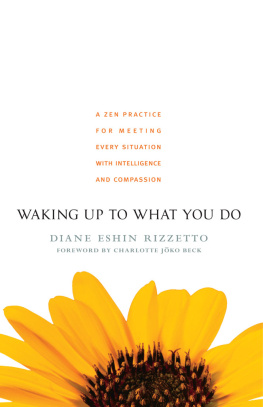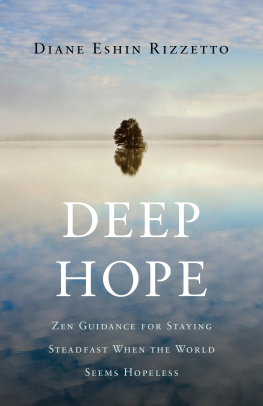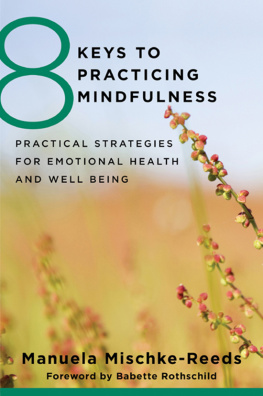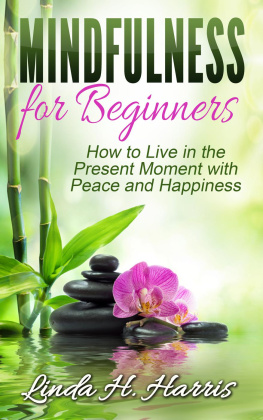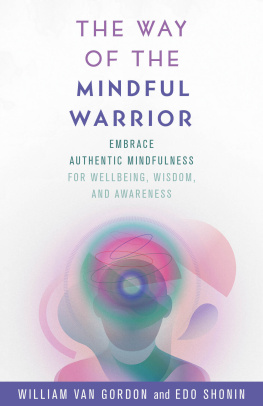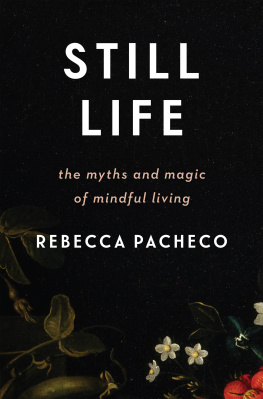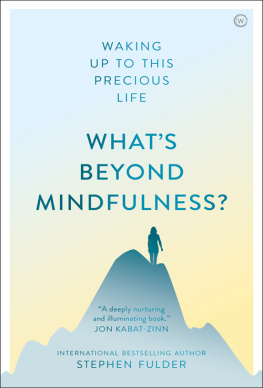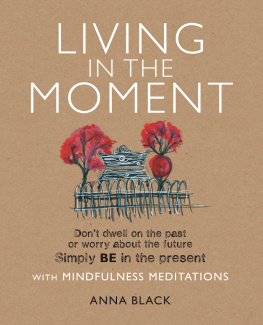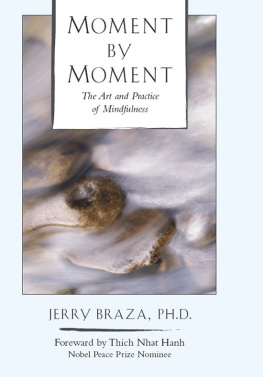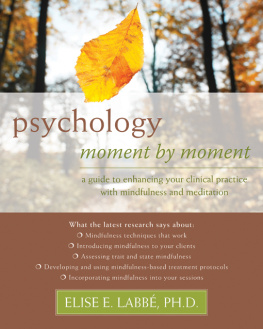I offer appreciation to my teacher, Charlotte Jko Beck, who continues to be a source of inspiration to me, to Sojun Mel Weitsman for his guidance in my early years of Zen practice, and to my Zen students whose insights have found their way into these pages and with whom I have the honor to share this practice. I also thank my family and all those who have helped through the various stages of writing this book. Finally, my deep appreciation to my husband, Jay, who so often serves as my lighthouse.
A P P E N D I X
What follows is meant to be a very general guideline for the person who would like to have some preliminary instruction about mindful awareness practice. If it is at all possible, however, it is advisable to receive instruction from a qualied teacher in person.
Try This
Right now, remain in the position you are insitting, standing, lying down. Dont change anything.
Now bring your attention to your breathing, making no attempt to change it. If its short, observe that. If its long, observe that. Pay attention as you take in air and breathe it out. Notice the chest rising, feel the sensations in your nostrils or mouth. Take just a minute or two to do this as you turn your awareness to your breathing. Dont complicate the exercise by trying to read into it. Just do it.
You have taken the rst step toward Stop. Look. Listen.
If you do nothing more than this activity for ve minutes every day, you will shortly begin to notice that your awareness sharpens and you can pick up more subtleties of your breath. The key is that you dont try to make anything special out of it. In fact, there is nothing mysterious at all about being awake and present to our breath or anything else in life. Its the most natural thing we can do as humansbeing present. In fact, we cant help but be present. The point is, we arent always awake to that fact.
During the course of events on any given day, we get sidetracked easily, and even taking ve minutes to develop the skill of stop-look-listen is not always easy. So it is useful to take up a structured approach to developing mindful awareness.
Taking a Position
Find a quiet place and a comfortable position in a chair or on a cushion. If you cannot use either of these positions, you can lie down or stand up. Several longtime practitioners at our Zen center do their awareness meditation lying down or standing because of physical limitations. Keep the eyes open and held at a 45-degree angle. Try to stay relaxed, but not limp or slouched. This means that you will want to pay attention to your body alignment.
Settling In
After youre somewhat settled in your physical position, just watch. In all likelihood, your mind will be lled with lots of thoughts or you may notice other various sensations in the body. This is normal and is going on all the time anyway. The only difference is that right now, youre aware of it.
Often these thoughts or other sensations will send a message to the body to move. It is said that when the mind moves, the body follows. If youre having a thought like, This is boring, then the body looks for something to do. It may shift position or begin to dget. Try to notice when this happens. The key, remember, is to take note, observe, not to try to maintain some ideal position. Waking up to how you are holding your body is much more important than making your body stay straight. It takes time for the body to learn to rest in stillness. The rush-hour trafc of the freeway doesnt always end just because our car takes the exit. Depending on our lifestyle, busy lives have a way of turning into busy minds and bodies.
Breathing
The rst thing we do when we are born is take in a breath. The last thing we do when we die is let out a breath. Breathing is one of the most fundamental activities we engage in. It supports us in a way nothing or no one else can, and when we observe it, it can calm us and help us see where we are at this moment.
The average person breathes sixteen breaths per minute while awake and about six to eight while sleeping. Thats roughly 960 breaths per hour or over 23,000 breaths in a twenty-four-hour period. Under stress, the number of breaths can jump to a hundred per minute; it can fall as low four or ve in deep meditation. Whether were conscious of it or not, its always with us, and when its not, we dont have to concern ourselves with it. We do it automatically or with control. So for the purposes of developing an awareness practice, the breath can be very useful. We can think of it as telling our mind, Okay. You want to put your attention somewhere, so put it here on the breath.
As you are sitting still, bring your attention to the breath coming in and out. Breathe naturally. You will nd that thoughts, feelings, and/or sensations arise. When they do, just note them and bring the attention back to the breath. Each time we bring the attention back to breathing, even if we do it a thousand times within a few minutes, our ability to be present deepens and our resistance to just sitting in the present moment lessens.
Scanning the Body
Now, starting at the tip of your head, slowly scan down your body with your attention from head to big toe, bringing awareness to places that you nd some holding. It might be helpful to think of the light beam shining down from the top of your head and spiraling down to your feet, lighting up your awareness.
Sometimes this exercise is used as a relaxation technique. However, here we are using it not primarily as a way to relax tensions in the body, but rather as way to bring attention to the places we hold in the body and in doing so, sharpen the blade of awareness. When we engage our mind in this way, quite often holdings will relax. If so, thats quite okay. Other times, people will become aware of emotional holdings within the bodily tension. This is a natural occurrence as awareness strengthens.
Observing Our Thoughts/Emotions
Usually our thoughts spin like a self-looping tape. After sitting for just a few minutes, you may discover that your thoughts are wandering, planning, or demanding something. Thinking is not bad or even undesirable. Whats important is not how many or what type of thoughts we have, but what we do with them.
At whatever point in your sitting you notice a thought, take note of its content. It doesnt matter whether it seems important or unimportant. Just label it silently. For example, if you have the thought, This is boring, then say to yourself, Having a thought that this is boring. When you notice the mind spinning, just label it, Having a thought the mind is spinning or Just Spinning.
You may begin to notice that some thoughts have more emotional content than others. This activity of the mind is sometimes called emotion-thought. For example, a thought such as, He treated me unfairly, may be accompanied by anger or sadness. Sometimes you may become aware of the emotion immediately and note the thought-sentence that accompanies it later. Whether you experience the thought or the emotion rst is of little signicance; the important point is simply to be aware of whatever is going onhow that emotion/thought expresses itself in the body.
Sensory Awareness
Emotion-thoughts always have an accompanying sensory experience, whether or not were awake to it. After a while you will be more alert to the sensory experience accompanying these emotion-thoughts. For example, if you have a thought like the example above, He treated me unfairly, you can label the thought, Having a thought he treated me unfairly, and then pause for a moment, just following your breath in and out, keeping the beam of awareness in the body, and with a soft query ask: Is there an emotion present? Sometimes you may feel nothing when your intellect tells you you should. Other times, you wont even have to query. In fact, you may notice a very strong emotion and not even know the thought behind it. This is often the case with anger. Everyone is different and all situations and holdings are different.
Next page
